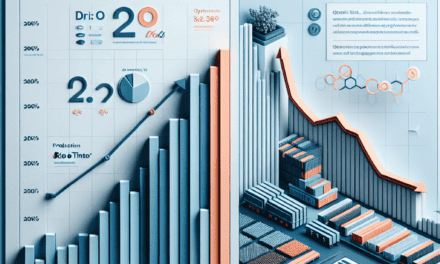“Johnson & Johnson Expands Horizons: $15 Billion Acquisition of Intra-Cellular to Innovate Mental Health Solutions.”
Introduction
Johnson & Johnson has announced its strategic decision to acquire Intra-Cellular Therapies for $15 billion, a move aimed at bolstering its portfolio in the neuroscience sector. This acquisition reflects Johnson & Johnson’s commitment to advancing innovative treatments for mental health disorders, leveraging Intra-Cellular’s expertise in developing therapies for conditions such as schizophrenia and bipolar disorder. The deal is expected to enhance J&J’s capabilities in addressing unmet medical needs and expanding its presence in the rapidly evolving pharmaceutical market.
Johnson & Johnson’s Strategic Move: $15 Billion Acquisition of Intra-Cellular
In a significant strategic move, Johnson & Johnson has announced its decision to acquire Intra-Cellular Therapies for a staggering $15 billion. This acquisition marks a pivotal moment for Johnson & Johnson, a company renowned for its commitment to innovation in the healthcare sector. By integrating Intra-Cellular’s portfolio, which includes groundbreaking treatments for neuropsychiatric disorders, Johnson & Johnson aims to bolster its position in the rapidly evolving pharmaceutical landscape.
The decision to acquire Intra-Cellular is rooted in the growing recognition of the importance of mental health treatments. As awareness of mental health issues continues to rise globally, the demand for effective therapies has surged. Intra-Cellular’s flagship product, Caplyta, has already demonstrated promising results in treating schizophrenia and bipolar disorder, making it an attractive asset for Johnson & Johnson. By incorporating Caplyta into its existing product lineup, Johnson & Johnson not only enhances its therapeutic offerings but also positions itself to address a critical area of unmet medical need.
Moreover, this acquisition aligns with Johnson & Johnson’s broader strategy of diversifying its pharmaceutical portfolio. The company has long been committed to expanding its reach beyond traditional therapeutic areas, and the addition of Intra-Cellular’s innovative treatments represents a significant step in that direction. As the healthcare landscape becomes increasingly competitive, having a diverse range of products is essential for sustaining growth and maintaining market leadership. By investing in Intra-Cellular, Johnson & Johnson is not only securing valuable intellectual property but also gaining access to a talented team of researchers and scientists dedicated to advancing mental health therapies.
In addition to enhancing its product offerings, Johnson & Johnson’s acquisition of Intra-Cellular is expected to yield substantial financial benefits. The pharmaceutical industry is characterized by high profit margins, and the integration of Intra-Cellular’s products could significantly contribute to Johnson & Johnson’s bottom line. Analysts predict that the acquisition will accelerate revenue growth, particularly as Caplyta continues to gain traction in the market. This financial upside is particularly appealing in an era where companies are increasingly scrutinized for their ability to deliver shareholder value.
Furthermore, the acquisition underscores Johnson & Johnson’s commitment to addressing the global mental health crisis. With millions of individuals affected by mental health disorders, the need for effective treatments has never been more urgent. By investing in Intra-Cellular, Johnson & Johnson is not only positioning itself as a leader in the pharmaceutical industry but also taking a proactive stance in improving the lives of those suffering from mental health conditions. This alignment of corporate strategy with societal needs reflects a growing trend among major corporations to prioritize social responsibility alongside financial performance.
As the integration process unfolds, stakeholders will be keenly observing how Johnson & Johnson leverages Intra-Cellular’s assets to drive innovation and expand its market presence. The success of this acquisition will depend on the company’s ability to effectively merge the two organizations while fostering a culture of collaboration and innovation. In conclusion, Johnson & Johnson’s $15 billion acquisition of Intra-Cellular represents a bold and strategic move that not only enhances its pharmaceutical portfolio but also underscores its commitment to addressing critical healthcare challenges. As the company embarks on this new chapter, the potential for growth and innovation in the mental health space appears promising, paving the way for a brighter future for both the organization and the patients it serves.
Implications of the Intra-Cellular Acquisition for Johnson & Johnson
Johnson & Johnson’s recent announcement regarding its $15 billion acquisition of Intra-Cellular Therapies marks a significant strategic move that could reshape the landscape of the pharmaceutical industry. This acquisition is not merely a financial transaction; it represents a calculated effort by Johnson & Johnson to enhance its portfolio in the rapidly evolving field of neuroscience. By integrating Intra-Cellular’s innovative therapies, particularly its lead product, Caplyta, which has shown promise in treating schizophrenia and bipolar disorder, Johnson & Johnson aims to solidify its position as a leader in mental health treatment.
The implications of this acquisition extend beyond the immediate financial investment. First and foremost, it underscores Johnson & Johnson’s commitment to addressing the growing global mental health crisis. With mental health disorders on the rise, driven by factors such as the COVID-19 pandemic and increasing societal pressures, the demand for effective treatments has never been more urgent. By acquiring Intra-Cellular, Johnson & Johnson is not only expanding its therapeutic offerings but also positioning itself to meet this critical need. This strategic alignment with mental health initiatives could enhance the company’s reputation as a socially responsible entity dedicated to improving patient outcomes.
Moreover, the acquisition is likely to bolster Johnson & Johnson’s research and development capabilities. Intra-Cellular has a robust pipeline of potential therapies that target various neurological conditions, which could complement Johnson & Johnson’s existing research efforts. By leveraging Intra-Cellular’s expertise in neuroscience, Johnson & Johnson can accelerate the development of new treatments, thereby enhancing its competitive edge in the pharmaceutical market. This synergy could lead to innovative solutions that address unmet medical needs, ultimately benefiting patients and healthcare providers alike.
In addition to expanding its therapeutic portfolio, the acquisition may also have significant financial implications for Johnson & Johnson. The integration of Intra-Cellular’s products could contribute to revenue growth, particularly as Caplyta gains traction in the market. Analysts predict that the demand for effective treatments for schizophrenia and bipolar disorder will continue to rise, providing Johnson & Johnson with a lucrative opportunity to capitalize on this growing market. Furthermore, the acquisition could lead to cost synergies through streamlined operations and shared resources, enhancing overall profitability.
However, it is essential to consider the potential challenges that may arise from this acquisition. Integrating a new company into an established organization can be complex, requiring careful management of corporate culture, operational processes, and regulatory compliance. Johnson & Johnson will need to navigate these challenges effectively to ensure a smooth transition and maximize the benefits of the acquisition. Additionally, the pharmaceutical industry is characterized by intense competition, and Johnson & Johnson must remain vigilant in its efforts to innovate and differentiate its products in a crowded marketplace.
In conclusion, Johnson & Johnson’s acquisition of Intra-Cellular Therapies represents a strategic initiative with far-reaching implications for the company and the broader pharmaceutical landscape. By enhancing its focus on mental health, bolstering research and development capabilities, and positioning itself for financial growth, Johnson & Johnson is taking a significant step toward addressing critical healthcare needs. While challenges may lie ahead, the potential rewards of this acquisition could ultimately lead to improved patient outcomes and a stronger market presence for Johnson & Johnson in the years to come.
Analyzing the Financial Impact of the $15 Billion Deal
The recent announcement by Johnson & Johnson regarding its $15 billion acquisition of Intra-Cellular Therapies marks a significant development in the pharmaceutical landscape, particularly in the realm of mental health treatment. This strategic move not only underscores Johnson & Johnson’s commitment to expanding its portfolio but also highlights the growing importance of innovative therapies in addressing complex neurological disorders. As we analyze the financial impact of this acquisition, several key factors come into play, including potential revenue growth, market positioning, and the implications for shareholders.
To begin with, the acquisition of Intra-Cellular is expected to enhance Johnson & Johnson’s revenue streams significantly. Intra-Cellular is known for its innovative treatments for schizophrenia and other neuropsychiatric conditions, which are increasingly prevalent in today’s society. By integrating Intra-Cellular’s product offerings, Johnson & Johnson can leverage its extensive distribution network and marketing capabilities to accelerate the commercialization of these therapies. This synergy is likely to result in increased sales and market penetration, ultimately contributing to the company’s top-line growth.
Moreover, the acquisition positions Johnson & Johnson favorably within the competitive landscape of the pharmaceutical industry. As mental health issues gain more recognition and demand for effective treatments rises, companies that can provide innovative solutions are poised for success. By acquiring Intra-Cellular, Johnson & Johnson not only diversifies its product portfolio but also strengthens its foothold in a market that is projected to grow substantially in the coming years. This strategic positioning could lead to enhanced competitive advantages, allowing the company to capture a larger share of the mental health market.
In addition to revenue growth and market positioning, the financial implications for shareholders are also noteworthy. While the initial outlay of $15 billion may raise concerns regarding short-term financial strain, it is essential to consider the long-term benefits that such an acquisition can yield. Historically, successful acquisitions have led to increased shareholder value, particularly when the acquired company possesses unique assets or technologies that can be effectively integrated into the parent company’s operations. If Johnson & Johnson can successfully harness Intra-Cellular’s innovations, the potential for substantial returns on investment could outweigh the initial costs.
Furthermore, the acquisition may also influence Johnson & Johnson’s stock performance in the broader market. Investors often react positively to strategic acquisitions that promise growth and diversification. As the news of the acquisition spreads, it is likely that investor sentiment will shift, potentially driving up the stock price in anticipation of future earnings growth. This positive momentum can create a favorable environment for Johnson & Johnson, enhancing its reputation as a forward-thinking leader in the pharmaceutical sector.
However, it is crucial to acknowledge the risks associated with such a significant acquisition. Integration challenges, regulatory hurdles, and the need for effective management of the newly acquired assets can pose obstacles that may impact the anticipated financial benefits. Therefore, Johnson & Johnson must approach this acquisition with a clear strategy and robust execution plan to mitigate these risks and ensure a smooth transition.
In conclusion, the $15 billion acquisition of Intra-Cellular by Johnson & Johnson represents a pivotal moment in the company’s trajectory, with far-reaching financial implications. By enhancing revenue potential, strengthening market positioning, and potentially increasing shareholder value, this acquisition could serve as a catalyst for future growth. Nevertheless, careful management and strategic execution will be essential to realize the full benefits of this ambitious endeavor.
Intra-Cellular’s Innovations: What Johnson & Johnson Gains
Johnson & Johnson’s recent announcement regarding its $15 billion acquisition of Intra-Cellular Therapies marks a significant milestone in the pharmaceutical landscape, particularly in the realm of mental health treatment. This strategic move not only underscores Johnson & Johnson’s commitment to expanding its portfolio but also highlights the innovative capabilities that Intra-Cellular brings to the table. As the healthcare industry increasingly recognizes the importance of addressing mental health issues, the acquisition positions Johnson & Johnson to leverage Intra-Cellular’s groundbreaking research and development in this critical area.
Intra-Cellular is renowned for its pioneering work in developing novel therapies for neuropsychiatric disorders, particularly its flagship product, lumateperone. Approved by the U.S. Food and Drug Administration for the treatment of schizophrenia, lumateperone represents a new class of antipsychotic medication that operates through a unique mechanism of action. Unlike traditional antipsychotics, which often come with a host of side effects, lumateperone has demonstrated a favorable safety profile, making it an attractive option for patients and healthcare providers alike. By acquiring Intra-Cellular, Johnson & Johnson gains access to this innovative treatment, which not only enhances its existing mental health portfolio but also aligns with the growing demand for effective and tolerable therapies in this field.
Moreover, Intra-Cellular’s robust pipeline of investigational drugs further amplifies the value of this acquisition. The company is actively exploring treatments for a range of conditions, including bipolar disorder and major depressive disorder. These ongoing clinical trials signify a commitment to advancing mental health care and addressing unmet needs within the patient population. By integrating Intra-Cellular’s research capabilities, Johnson & Johnson can accelerate the development of these promising therapies, thereby reinforcing its position as a leader in the mental health sector.
In addition to the therapeutic innovations, the acquisition also provides Johnson & Johnson with valuable intellectual property and expertise in the field of neuroscience. Intra-Cellular’s team comprises seasoned professionals with extensive experience in drug development and clinical research. This infusion of talent can enhance Johnson & Johnson’s existing capabilities, fostering a culture of innovation that is essential for navigating the complexities of modern drug development. Furthermore, the collaboration between the two organizations can lead to synergistic opportunities, enabling the exploration of combination therapies that may yield even greater efficacy for patients.
The strategic rationale behind this acquisition is further underscored by the increasing recognition of mental health as a critical component of overall health. The COVID-19 pandemic has exacerbated mental health challenges globally, leading to a surge in demand for effective treatments. By acquiring Intra-Cellular, Johnson & Johnson positions itself to meet this growing need, ultimately contributing to improved patient outcomes and quality of life.
In conclusion, Johnson & Johnson’s acquisition of Intra-Cellular Therapies represents a forward-thinking approach to addressing the pressing challenges in mental health care. By harnessing Intra-Cellular’s innovative therapies, robust pipeline, and expert team, Johnson & Johnson not only enhances its therapeutic offerings but also solidifies its commitment to advancing mental health treatment. As the healthcare landscape continues to evolve, this acquisition may well serve as a catalyst for transformative change in the way mental health disorders are treated, ultimately benefiting patients and healthcare providers alike.
Market Reactions to Johnson & Johnson’s Acquisition Announcement
The recent announcement by Johnson & Johnson regarding its $15 billion acquisition of Intra-Cellular Therapies has elicited a range of reactions from market analysts, investors, and industry experts. This strategic move is seen as a significant step for Johnson & Johnson, particularly in enhancing its portfolio in the neuroscience sector. As the pharmaceutical giant aims to bolster its capabilities in developing innovative treatments for mental health disorders, the market’s response has been closely monitored.
Initially, the stock market reacted positively to the news, with shares of Johnson & Johnson experiencing a notable uptick. Investors expressed optimism about the potential synergies that could arise from the acquisition, particularly given Intra-Cellular’s promising pipeline of therapies aimed at addressing serious psychiatric conditions. The acquisition is expected to provide Johnson & Johnson with access to Intra-Cellular’s lead product, Caplyta, which has already shown efficacy in treating schizophrenia and bipolar disorder. This aspect of the deal has been highlighted by analysts as a key driver of future revenue growth, thereby enhancing the overall valuation of Johnson & Johnson.
Moreover, the acquisition aligns with a broader trend in the pharmaceutical industry, where companies are increasingly seeking to expand their therapeutic areas through strategic mergers and acquisitions. This trend is particularly evident in the mental health space, which has garnered heightened attention in recent years due to the growing prevalence of mental health disorders and the corresponding demand for effective treatments. As such, Johnson & Johnson’s acquisition of Intra-Cellular is not only a tactical maneuver but also a reflection of the evolving landscape of healthcare, where mental health is becoming a focal point for innovation and investment.
However, while the initial market reaction was favorable, some analysts have raised concerns regarding the financial implications of the acquisition. The $15 billion price tag represents a significant investment, and questions have been raised about whether the anticipated returns will justify the expenditure. Critics argue that the integration of Intra-Cellular’s operations and culture into Johnson & Johnson’s existing framework may pose challenges, potentially impacting the overall efficiency of the combined entity. Furthermore, the pharmaceutical industry is characterized by inherent risks, including regulatory hurdles and the unpredictability of clinical trial outcomes, which could affect the success of Intra-Cellular’s product pipeline.
In light of these considerations, investors are advised to adopt a cautious approach as they assess the long-term implications of the acquisition. While the potential for growth in the mental health sector is substantial, it is essential to remain vigilant about the challenges that may arise during the integration process. Additionally, market analysts will be closely monitoring Johnson & Johnson’s subsequent financial performance and strategic decisions in the wake of this acquisition, as these factors will ultimately determine the success of the investment.
In conclusion, Johnson & Johnson’s $15 billion acquisition of Intra-Cellular Therapies has sparked a multifaceted response from the market, characterized by both optimism and caution. As the pharmaceutical giant seeks to enhance its position in the neuroscience field, the implications of this acquisition will unfold over time. Stakeholders will be keenly observing how effectively Johnson & Johnson navigates the complexities of integration and capitalizes on the opportunities presented by Intra-Cellular’s innovative therapies. Ultimately, the success of this acquisition will hinge on the company’s ability to leverage its resources and expertise to drive meaningful advancements in mental health treatment.
Future Prospects for Johnson & Johnson Post-Acquisition
The recent announcement of Johnson & Johnson’s $15 billion acquisition of Intra-Cellular Therapies marks a significant strategic move for the pharmaceutical giant, positioning it for enhanced growth and innovation in the biopharmaceutical sector. This acquisition is not merely a financial transaction; it represents a calculated effort to expand Johnson & Johnson’s portfolio, particularly in the realm of central nervous system disorders, an area that has historically been underrepresented in its offerings. By integrating Intra-Cellular’s innovative therapies, Johnson & Johnson aims to leverage its extensive resources and expertise to accelerate the development and commercialization of new treatments.
As the healthcare landscape continues to evolve, the demand for effective therapies targeting mental health conditions is on the rise. Intra-Cellular’s lead product, Caplyta, has already shown promise in treating schizophrenia and bipolar disorder, and its potential applications could extend to other neuropsychiatric conditions. This aligns seamlessly with Johnson & Johnson’s commitment to addressing unmet medical needs, particularly in mental health, which has gained increasing attention in recent years. By acquiring Intra-Cellular, Johnson & Johnson not only enhances its therapeutic offerings but also positions itself as a leader in a critical and growing market.
Moreover, the acquisition is expected to bolster Johnson & Johnson’s research and development capabilities. Intra-Cellular has a robust pipeline of candidates that could complement Johnson & Johnson’s existing projects. The integration of Intra-Cellular’s innovative research methodologies and technologies could lead to breakthroughs in drug development, particularly in areas where traditional approaches have fallen short. This synergy is likely to foster a culture of innovation within Johnson & Johnson, encouraging cross-collaboration between teams and ultimately leading to the discovery of novel therapies.
In addition to enhancing its product pipeline, Johnson & Johnson’s acquisition of Intra-Cellular is poised to improve its competitive positioning in the pharmaceutical industry. As larger companies increasingly focus on specialized therapies, the ability to offer a diverse range of effective treatments becomes paramount. By incorporating Intra-Cellular’s expertise, Johnson & Johnson can differentiate itself from competitors, thereby attracting a broader patient population and healthcare providers seeking comprehensive treatment options.
Furthermore, the financial implications of this acquisition cannot be overlooked. While the initial investment of $15 billion is substantial, the long-term revenue potential from successful product launches and market penetration could far outweigh the costs. Analysts predict that the mental health market will continue to expand, driven by increasing awareness and the destigmatization of mental health issues. As a result, Johnson & Johnson stands to benefit significantly from this acquisition, potentially leading to increased shareholder value and sustained growth.
In conclusion, Johnson & Johnson’s acquisition of Intra-Cellular Therapies represents a strategic initiative that aligns with the company’s long-term vision of innovation and leadership in healthcare. By enhancing its portfolio in the mental health space, bolstering research capabilities, and improving competitive positioning, Johnson & Johnson is well-equipped to navigate the complexities of the pharmaceutical landscape. As the integration process unfolds, stakeholders will be keenly observing how this acquisition translates into tangible outcomes, both in terms of new therapies and overall market performance. The future prospects for Johnson & Johnson post-acquisition appear promising, with the potential to redefine its role in addressing critical health challenges and improving patient outcomes.
The Role of Mergers and Acquisitions in the Pharmaceutical Industry
Mergers and acquisitions (M&A) play a pivotal role in the pharmaceutical industry, serving as a strategic mechanism for companies to enhance their capabilities, expand their product portfolios, and ultimately drive growth. The recent announcement by Johnson & Johnson regarding its $15 billion acquisition of Intra-Cellular highlights the significance of such transactions in a sector characterized by rapid innovation and intense competition. In this context, M&A activities are not merely financial maneuvers; they represent a calculated approach to addressing the evolving needs of the market and the complexities of drug development.
One of the primary motivations behind M&A in the pharmaceutical industry is the pursuit of innovation. As companies strive to develop new therapies and treatments, acquiring firms with promising research and development pipelines can provide a shortcut to accessing novel technologies and compounds. For instance, Intra-Cellular is known for its innovative approaches to treating neuropsychiatric disorders, and by acquiring this company, Johnson & Johnson can bolster its own research initiatives and enhance its therapeutic offerings. This strategic alignment not only accelerates the development of new drugs but also mitigates the risks associated with in-house research, which can be both time-consuming and costly.
Moreover, mergers and acquisitions enable pharmaceutical companies to achieve economies of scale. By consolidating operations, firms can reduce redundancies, streamline processes, and lower production costs. This is particularly important in an industry where the financial burden of drug development is substantial, often exceeding billions of dollars for a single product. The acquisition of Intra-Cellular allows Johnson & Johnson to leverage its existing infrastructure and resources, thereby optimizing its operational efficiency. As a result, the company can allocate more resources toward innovation and market expansion, ultimately benefiting patients and shareholders alike.
In addition to enhancing innovation and operational efficiency, M&A activities can also facilitate market expansion. By acquiring companies with established market presence or unique therapeutic offerings, larger pharmaceutical firms can quickly enter new markets or strengthen their position in existing ones. This is particularly relevant in the context of global health challenges, where the demand for effective treatments is ever-increasing. Johnson & Johnson’s acquisition of Intra-Cellular not only provides access to new therapeutic areas but also positions the company to respond more effectively to the diverse needs of patients worldwide.
Furthermore, the competitive landscape of the pharmaceutical industry necessitates that companies remain agile and responsive to changes in market dynamics. Mergers and acquisitions can serve as a strategic response to competitive pressures, allowing firms to adapt to shifting consumer demands and regulatory environments. In an era where personalized medicine and targeted therapies are gaining prominence, acquiring companies with specialized expertise can provide a competitive edge. Johnson & Johnson’s strategic move to acquire Intra-Cellular exemplifies this approach, as it enables the company to enhance its capabilities in addressing complex health issues.
In conclusion, the role of mergers and acquisitions in the pharmaceutical industry is multifaceted, encompassing innovation, operational efficiency, market expansion, and competitive positioning. The recent acquisition of Intra-Cellular by Johnson & Johnson underscores the importance of these strategic transactions in navigating the complexities of drug development and addressing the evolving needs of patients. As the industry continues to evolve, M&A will remain a critical tool for companies seeking to enhance their capabilities and drive sustainable growth in an increasingly competitive landscape.
Q&A
1. **What is the value of Johnson & Johnson’s acquisition of Intra-Cellular?**
– $15 billion.
2. **What company is being acquired by Johnson & Johnson?**
– Intra-Cellular Therapies.
3. **What is the primary focus of Intra-Cellular Therapies?**
– Developing treatments for neuropsychiatric diseases.
4. **What strategic goal does this acquisition support for Johnson & Johnson?**
– Expanding its pharmaceutical portfolio, particularly in mental health.
5. **When was the acquisition announced?**
– The specific date of the announcement is not provided.
6. **What potential benefits does Johnson & Johnson expect from this acquisition?**
– Enhanced innovation and access to Intra-Cellular’s drug pipeline.
7. **How might this acquisition impact the healthcare market?**
– It could lead to new treatment options for patients with mental health disorders.
Conclusion
Johnson & Johnson’s $15 billion acquisition of Intra-Cellular Therapeutics represents a strategic move to enhance its portfolio in the neuroscience sector, particularly in developing treatments for mental health disorders. This acquisition underscores J&J’s commitment to expanding its innovative capabilities and addressing unmet medical needs, positioning the company for future growth in a critical area of healthcare.





